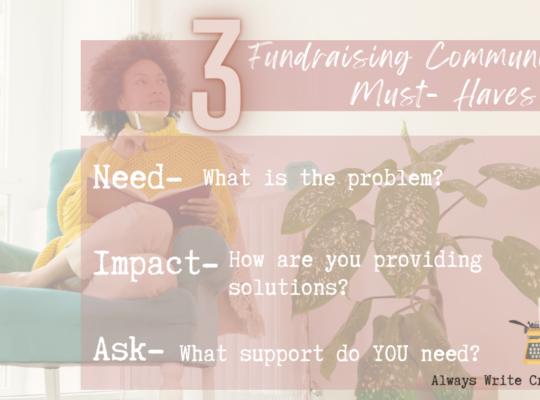By Brandee A. Thomas, Always Write Creatives CEO
“Why not us? We have something to say too.”
I can’t tell you how many times I’ve heard nonprofit leaders say this when they find out about another organization getting a sizeable donation or being interviewed by the media.
If I’m honest, as the former executive director of a smaller nonprofit – our original, annual budget was barely $100,000 – I’d wondered the same thing.
I remember thinking, “They aren’t doing half the work that we are, so why are they getting all the attention.” I KNEW we were doing good work and I knew how much MORE we could do with more community support.
SO WHY DIDN’T ANYONE KNOW WE WERE THERE??
It took a minute to get to the root of the problem, but I finally realized what they had that we were missing.
Stories.
The truth of the matter is they told their story better than we did and by doing so, they’d positioned themselves as experts in the community. Whenever an issue came up that was remotely related to their work, the media – and donors – automatically thought of them first.
When they remembered we were there, people thought they had an idea of the work we were doing, but they didn’t really know. And it was our fault. We weren’t being proactive in telling our own story, so they created a narrative for us. And sadly, that narrative didn’t always convert into donations or other support.
To quote the great Audre Lorde, “If you do not define yourself, for yourself, you will be defined by others. For their use and to your detriment.”
That would never do, so I got to work.
- Step One: Step up internal communications. Informed staff, board members and volunteers are invaluable brand ambassadors. Make sure they are familiar with your work. They should easily be able to relay your 5 W’s (who, what, when, where and why).
- Step Two: Proactively share your program successes – and challenges. People can’t applaud if they don’t know what you’re doing well, and they can’t help if they don’t know you have a need.
- Step Three: Get to know the ins and outs of your organization. Some of the best stories come from your frontline team members. To deliver main character energy, the storyteller needs to be close to the source. You want your audience to connect to your story and it’s kind of hard to do when they feel like they’re reading a technical manual.
Story ideas are all around you. Highlight a team member. Analyze your program data and share your findings. Write a narrative about how your organization got started.
Need assistance getting started? Always Write Creatives can help. Our Communications Coaching package is a great way to start building your story bank.

Stories equal dollars.
Dollars equal new possibilities for your brand, your work, your mission.
What program could you expand if you had more money?
How many new team members could you hire?
How would your mission be impacted?
Think about it.
What’s your story?




